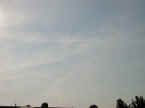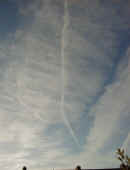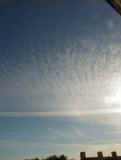Contrails and Aviation-induced Cirrus Clouds
Remarks and personal opinions (01)

|
Click
Plane for next page of Remarks and Personal Opinions (02)
|

|
June
8th, 2000: "Literally not one little cloud in the
sky"
|
|

|
I started taking pictures of contrails in 1995, not knowing what
they were called and not realizing that they not just ugly but also (and mainly)
hazardous to the health of our climate. In the beginning I scanned the
photographs in order to obtain digital pictures. Later, I used a digital Olympus
Camedia camera. Since May 2002, I use a Minolta Dimage X.. The picture
underneath was taken in 1995.
|
|
|

|
'What a beautiful
evening' sighed the young couple at the table next to us, somewhere at the
waterside in the centre of Amsterdam..
Some people actually like contrails and
their grand designs in a once-blue sky. Other people love to watch car crashes
or other incidents. Beauty is in the eyes of the beholder.
|
|
The debate should
no longer be about the cosmetic value of contrails, but about their impact and
their consequences. At the moment, the burden of proof lies with the people who
worry about the harm contrails could do, not with those who cause these changes
in the sky. 'It's the economy, stupid'.
When the sky is
cloudy or hazy with natural (?) cirrus, contrails are hard to see, even for
the experienced contrail-watcher. On July 18th, contrails had been only vaguely
visible during the greater part of the day. Only after the sky cleared and with
the setting sun, the contrails became distinct. 'What a beautiful evening'.
|

|
July 31st,
1999:
KNMI predicts:
'The suns shines fully. Tomorrow there will be some more clouds. This
morning the sky is clear and deepblue. [...] Some cumulus-clouds will hardly
hinder the force of the sun'
MeteoConsult agrees:
'The weather becomes monotonous. No signs of change in the wheathercharts. [...]
Tomorrow August 1st some high clouds will drift in from the South. These
are the first signs of a change in the wheather.'
|
|
In reality the first contrails
appeared yesterday afternoon, after six days of full sunshine and
deep-bvlue skies. This morning the sky was covered with persistent
contrails, developing into milky cirrus-clouds, filtering the light of the
sun.
Weather is hard to predict, so
forecasts have a strong element of uncertainty.
Not telling the truth is quite another matter, though.
The heavy and persistent
contrails and aviation-induced cirrus-clouds of July 31st, 1999, were to be expected. Some
meteorologists rather ignore them. They will have to learn the meteoroligical
impact of this unmeteorological phenomenon.
|
|
Most of the time you can only see contrails and aviation-smog when trying to
look straight into the sun. Elsewhere this thin layer of man-made clouds is
hardly visible. Still, it filters the sun's light.
At sunset you can at last see contrails and aviation-cirrus that during the day
have been covering the sky invisibly.
Vliegtuigstrepen, -wolken en -smog zijn vaak alleen te zien als u in de
richting van de zon kijkt.
Zij zijn het best zichtbaar als de zon er dwars doorheen schijnt of van opzij,
bij zonsopgang en -ondergang. Zij kunnen vrijwel de gehele hemel bedekken
zonder dat de meeste mensen zich daar bewust van zijn. Zelfs aan het gefilterde
zonlicht als gevolg van luchtvaartsmog zijn mensen gewend geraakt.
|
|
People have no idea how much cirrus- cloudiness is actually caused by
aviation. This is also caused by the thinness of the layer of water, CO2,
soot, acids and whatever more, that is weaved around our world by growing
aviation. Weather reports in newspapaer and on radio and TV do little to arouse
public awareness of causes and consequences of the increase of cloudiness due to
aviation.
|

|
On June 9th in 2000 mr Harry Geurts, meteorologist and spokesman of KNMI (Royal Dutch
Meteorological Institute) wrote in De Telegraaf (Holland's largest newspaper)
that on there previous day (June 8th)
there was "literally not one little cloud in the
sky".
The picture on the left was taken on June 8th. It shows how the sky really looked...
Weather and climate have become matters of commercial interest and professional
controversy.
|
|
|
Aviation brings vast amounts of water to the top of our troposphere, where it
stays for a long time before mixing with lower levels. Raising of the level of
vapour in our atmosphere cannot be without consequences.
Part of the problem is that the contrails and 'cirrus aviaticus' that
you do not see, that should really worry you. In many cases this
aviation-induced cloudiness can only be seen when the sun shines sideways
A meteorologist (who prefers to remain anonymous) writes that pilots report
that contrails only occur in a very thin layer of our atmosphere, around the
tropopause. This layer has a thickness of not more than a few thousand feet.
This thinness makes the remnants of aircraft emissions almost invisible in the
daytime, when the sun shines straight through this only partly visible layer of
water (ice), CO2, soot (aerosols) and whatever more.. In the morning and
evening, with the light of the sun coming from sideways, the thin coat of
pollution becomes visible as a veil covering the sky.
Most of the time only an experienced contrail-watcher can that aviation has
caused the the sky to be a bit opaque and not of a deep and clear blue colour.
Most people have grown used to this phenomenon, as the change happened very
slowly and gradually.
It seems as if the quality of the sunlight has changed. It seems whiter,
sharper, it has more 'bite'. This may be caused by the thin layer of ice
crystals that aviation is weaving around the world.
Most of the time the thin layers of ice clouds at high altitude can only be
seen in the mornings and evenings. The message is: Don't just look at the easily
recognizable contrails and 'cirrus aviaticus', but read also the veiled message
between these white lines.
|

|
June 16th 2000:
"The sun will get a lot of room, especially in the morning", writes
Klaas Dros, another weather-wizard, in de Volkskrant. The following picture was
taken on that same morning. Poor sun...
|
|
|
 |

|
 |
Most of the time contrails and especially
aviation-cirrus appear only when the sun sets in a virtually 'cloudless'
sky. The light of the sun shines from sideways on the relatively thin
layer of aviation-induced cirrus-clouds. The fact is, however, that this
unnatural cirrus has been there all day, but only becomes visible for a
short time.
The middle and right picture show the contrails and aviation-cirrus that
were there all day on December 11th, 2001.
Sometimes you can only see contrails and aviation-smog when
trying to look straight into the sun. This damages both your yes and your
camera, though.
You need to have an open mind and an open eye to see the effects of
aviation.
By the time these effects are fully realized, much valuable time
will have passed that should have been spent on doing something about it.
|
|

|
|
Als het zonlicht onder een rechte hoek door luchtvaartcirrus schijnt,
wordt dit gefilterd.
Als het onder een kleinere hoek erdoorheen schijnt, wordt het 'witte'
zonlicht gebroken en zijn de samenstellende golflengten (kleuren)
zichtbaar in de vorm van een 'halo', een soort regenboog rondom de zon,
zoals op 11 november 2001 (foto hierboven).
Door de
groei van het luchtverkeer, neemt ook het aantal van die veelkeurige
halo's toe. Het is onwaarschijnlijk dat de invloed die
luchtvaartcirrus heeft op het zonlicht dat het aardoppervlak bereikt, geen
gevolgen zou hebben voor (bijvoorbeeld) aardse groei- en ziekteprocessen.
|

|










